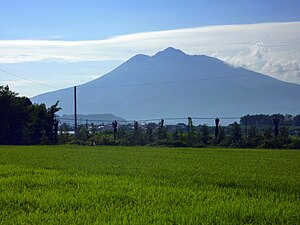Tsugaru, Aomori
|
Tsugaru つがる市 |
|||
|---|---|---|---|
| City | |||

Mount Iwaki stands prominently to the southwest
|
|||
|
|||
 Location of Tsugaru in Aomori Prefecture |
|||
| Coordinates: 40°48′31.4″N 140°22′48.2″E / 40.808722°N 140.380056°ECoordinates: 40°48′31.4″N 140°22′48.2″E / 40.808722°N 140.380056°E | |||
| Country | Japan | ||
| Region | Tōhoku | ||
| Prefecture | Aomori Prefecture | ||
| Area | |||
| • Total | 253.55 km2 (97.90 sq mi) | ||
| Population (November 1, 2015) | |||
| • Total | 34,301 | ||
| • Density | 135/km2 (350/sq mi) | ||
| Time zone | Japan Standard Time (UTC+9) | ||
| - Tree | Japanese Black Pine | ||
| - Bird | Common cuckoo | ||
| Phone number | 0173-42-2111 | ||
| Address | 61-1 Kizukuri Wakamidori, Tsugaru-shi, Aomori-ken 038-3192 | ||
| Website | Official website | ||
Tsugaru (つがる市 Tsugaru-shi?) is a city located in northwestern Aomori Prefecture in the northern Tōhoku region of Japan.
As of September 1, 2015, the city had an estimated population of 34,301 and a population density of 135 persons per km². The total area was 253.55 square kilometres (97.90 sq mi). The city's name is atypical for a Japanese place name in that it is written in hiragana rather than kanji (see hiragana cities).
Tsugaru is located on the west coast of Tsugaru Peninsula, facing the Sea of Japan. The city has a cold maritime climate characterized by cool summers and cold winters with heavy snowfall.
Lord Tsugaru has been mentioned in folklore along with Harada Kurando involving fencing and a tale of a "white serpent God." The area of Tsugaru was part of the holdings of the Tsugaru clan of Hirosaki Domain in the Edo period.
The modern city of Tsugaru was established on February 11, 2005, from the merger of the town of Kizukuri, and the villages of Inagaki, Kashiwa, Morita and Shariki (all from Nishitsugaru District).
...
Wikipedia



